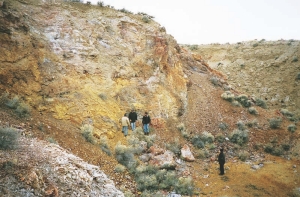VANCOUVER–Gold Canyon Resources’ (GCU-V, GDCRF-O) has significantly boosted the resource at its Cordero gallium project, in north-central Nevada’s Humboldt Cty.
An updated resource estimate pegs measured and indicated resources at 15 million tonnes averaging 47.7 parts per million (ppm) gallium for about 714,000 kg of the specialty metal — more than doubling the previous tally from early 2006. Another 6.6 million inferred tonnes at 43.7 ppm gallium was also recently reviewed, for roughly 335,000 kg. The resource estimate uses a 30 ppm gallium cutoff grade.
Since its earlier estimate, Gold Canyon has completed a further 81 reverse-circulation (RC) drill holes totalling 5,745 metres. The project has seen a total of 163 RC holes (12,190 metres) — for a roughly 30-metre drill density over the deposit area.
Situated on the southeast rim of the large McDermitt volcanic caldera, the Cordero project hosts gallium mineralization in Tertiary-aged andesitic and rhyolitic flows and tuffs that are iron-enriched and strongly clay-altered. Gallium was emplaced by epithermal hot springs activity and forms an envelope mostly along the hangingwall of the major northeast-trending M fault and other parallel faults that likely served as the conduits for mineralizing fluids.
To date, Gold Canyon has really only focused on the upper, near-surface oxidized zone with gallium mineralization. A deeper zone of sulphide-rich mineralization (primarily pyrite) was encountered in a few drill holes and found to contain similar concentrations of the metal. The project also contains rare earth elements.
The company touts Cordero as the largest primary gallium resource in North America. Most of the world’s gallium is produced as a byproduct from processing bauxite ore to produce aluminum, with some coming from zinc production. A significant amount of the metal also comes from recycling.
Gallium has recently been priced at around US$570 per kg.
About 95% of gallium produced is used in the electronics industry — specifically in the production of semiconductors used in cell phones, high-efficiency photocells and solar panels, and in light-emitting diodes.
The magnetic metal is soft at room temperature and melts at just 30 Celsius, but does not boil until 2,403.
Gold Canyon recently began a large-diameter drill program at Cordero to extract a bulk sample for metallurgical testing. Data from the program will be incorporated into a prefeasibility study.
In mid-February, Gold Canyon amended its agreement with royalty holder Tech Industries with respect to the Cordero and Caley properties, whereby Gold Canyon will be entitled, at any time before commercial production is reached, to reduce the 3% net smelter return royalty (at Cordero) and lease agreement (at Caley), concurrently, by up to 1.5% by paying Tech US$500,000 for every 0.5%.
Gold Canyon is still obligated to pay a separate 1% NSR to Cordero Mine Inc.
In addition to Cordero, the company is exploring its Springpole gold project, near Red Lake, in northwestern Ontario, where it has a few projects optioned out to other companies.
Based on its roughly 50 million shares outstanding, Gold Canyon posts a $25-million market capitalization at its recent share price of around 50. The stock has a 52-week trading range of 32-93.


Be the first to comment on "Gold Canyon boosts Cordero gallium resource (March 03, 2008)"